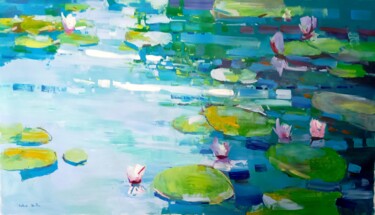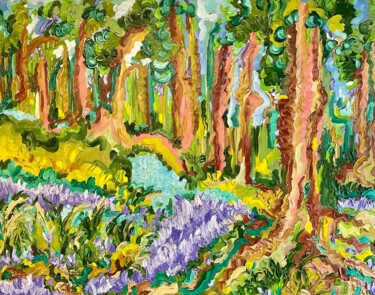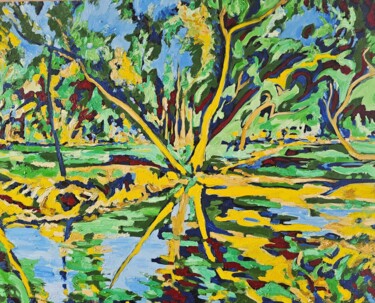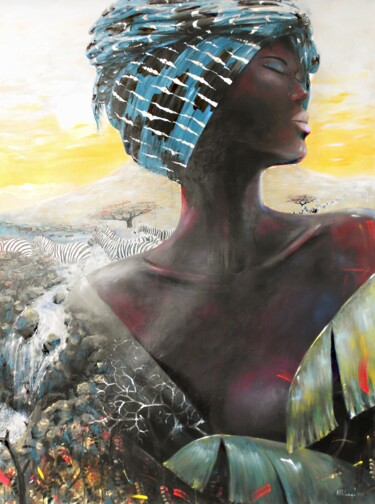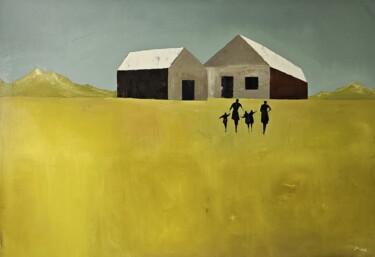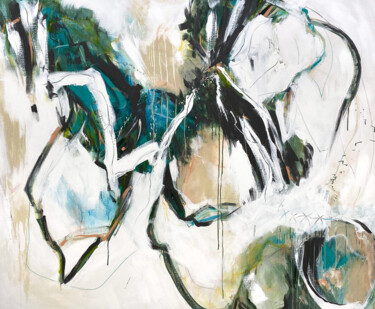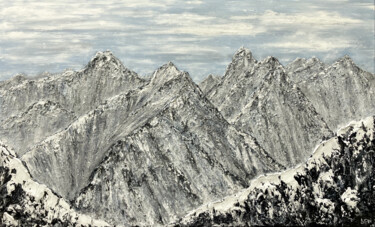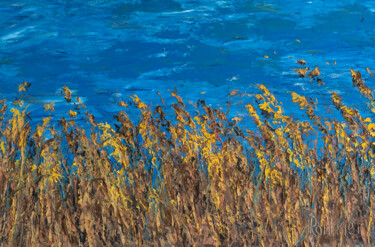199 Oryginalne obrazy na sprzedaż:
Kupowanie dzieł sztuki na temat „ Krajobraz ”
Wieś, góry, lasy, miasteczka, plaże... Odtworzenie możliwie wiernie obserwowanych krajobrazów było przez długi czas ostatecznym celem wielu artystów. Z biegiem czasu malarstwo pejzażowe ewoluowało wraz z pojawieniem się różnych nurtów malarskich, które dały artystom możliwość wyrażenia swoich wizji pejzaży. Świecące zachody słońca, pola kwiatów i wiejskie krajobrazy, dzika i nieokiełznana przyroda są często niewyczerpanym źródłem inspiracji dla artystów. Wśród malarzy, którzy wyróżnili malarstwo pejzażowe, możemy wymienić np. Nicolasa Poussina, Vincenta van Gogha, Paula Cézanne'a, Le Douaniera Rousseau.
Szukasz Oryginalne obrazy na sprzedaż ?
Poznaj wszystkie style i wszystkie techniki malarskie: malarstwo współczesne, street art, sztukę abstrakcyjną, sztukę figuratywną, pejzaże, portrety, martwe natury, akty, akwarele, malarstwo olejne, malarstwo akrylowe… Artmajeur jest dla każdego artystyczną wrażliwością i celebruje piękno u twego boku 20 lat z ponad 2 milionami współczesnych dzieł sztuki do odkrycia... lub zdobycia! Światowy wzorzec współczesnego malarstwa. Odkryj dzieła współczesnych artystów z całego świata, aby udekorować swoje wnętrze z klasą! Prosty miłośnik sztuki czy potwierdzony kolekcjoner? Znajdź ulubione płótno lub obraz, który naprawdę wzbogaci Twoją dekorację. Artmajeur oferuje oryginalne prace, limitowane edycje i druki artystyczne najlepszych współczesnych artystów na świecie. Na Artmajeur obrazy wybierane są przez pasjonatów i znawców rynku sztuki. Wybieramy dla Ciebie oryginalne dzieła modnych, nagradzanych i uznanych malarzy, a także nowe, wschodzące wartości w dziedzinie sztuki współczesnej, aby poprowadzić Cię i pomóc w procesie zakupu obrazów online.
Jak kupić pejzaż online?
Jak możesz podkreślić dekorację swojego domu pejzażem inspirowanym współczesnymi artystami?
Krajobrazy są jednym z głównych źródeł inspiracji artystów na całym świecie. Impresjonizm był bardzo inspirujący dla malarzy, którzy uwielbiają przedstawiać Naturę. Zazwyczaj ręcznie malują różne elementy na płótnie olejem, akrylem lub akwarelą w motywie pejzażu.
Wyobraź sobie ścianę w swoim salonie ozdobioną dużym, współczesnym pejzażem, oprawionym i ręcznie podpisanym przez współczesnego artystę inspirowanego impresjonizmem lub sztuką abstrakcyjną.
Możesz także dodać starodawny obraz wioski do jadalni lub pokoju biurowego... Przedstawiając naturalne elementy i sceny, artyści reprezentowali Naturę w jej różnorodności... Kiedy oglądasz pejzaże, nie są one wcale abstrakcyjne, możesz wyobrazić sobie światło, zapach i dźwięki naturalnych scen.
Jeśli potrzebujesz inspiracji, możesz wpisać w google "sprzedane malarstwo pejzażowe". Zobaczysz trendy online sprzedawane przez artystów z całego świata.
Krajobraz ma duże znaczenie, możesz filtrować wyszukiwanie „kup malarstwo krajobrazowe online”, dodając słowa kluczowe, takie jak
- przyroda, natura, dolina, góry
- Wiosna Lato Jesień Zima
- wieś, miasto, zamek
- abstrakcyjny, vintage, impresjonizm
Obrazy pejzażowe są bardzo popularnymi dziełami sztuki sprzedawanymi na Artmajeur.
Możesz kupić oryginalny obraz lub możesz mieć inne opcje, takie jak
- kup wydruki artystyczne w otwartej lub limitowanej edycji, jako plakat lub płótno
- kup licencję cyfrową do druku
- skontaktuj się z artystami, aby zamówić niestandardowe dzieła sztuki
Jednym z najszybszych sposobów na zakup artystycznego obrazu jest zakup obrazu pejzażowego przez Internet . Kupowanie obrazu przez Internet ma wiele zalet, m.in. oszczędność czasu, unikanie fizycznego odwiedzania galerii. Możesz kupować dzieła sztuki na stronie poświęconej sztuce i dostarczać je w dowolne miejsce. Możesz całkowicie przemodelować swój wystrój domu, dodając nowe opcje i rozmiary obrazów, które nadadzą mu niepowtarzalny charakter, szczególnie z abstrakcyjnym lub figuratywnym obrazem pejzażowym na ścianie w salonie.
Kolekcjonerzy sztuki lubią kupować obrazy krajobrazowe online, ponieważ mają mnóstwo wolnego czasu na filtrowanie najlepszych dzieł sztuki. Rzeczywiście, możesz rozszerzyć swoje wyszukiwanie i kupić malarstwo pejzażowe na znanych rynkach sztuki. Wśród nich Artmajeur jest znany z tego, że ma najniższą prowizję za sztukę w Internecie, aby wspierać artystów. Na Artmajeur na pewno znajdziesz tysiące obrazów pejzażowych na sprzedaż i będziesz mógł je przefiltrować, aby uzyskać najlepszy wybór na naszej stronie.
Jeśli kupisz obraz online w galerii, możesz uzyskać obniżone ceny od artystów lub kupony ze strony internetowej.
Jeśli jesteś miłośnikiem sztuki z małym portfelem, możesz złożyć artyście oferty cenowe lub zamówić wydruk oryginalnego dzieła sztuki. Te opcje oferuje Artmajeur.
Gdy masz duży wybór, który może pasować do Twojego wystroju ściany, musisz przefiltrować rozmiar i kolory grafiki, którą chcesz kupić.
Rzeczywiście, wybierzesz obrazy krajobrazowe według żądanego rozmiaru, małego, średniego lub dużego. Strony internetowe o sztuce umożliwiają na przykład dodanie zakresu cali.
Zastanów się, co naprawdę lubisz, abstrakcyjne pejzażowe pejzaże na płótnie z olejem szpachlowym, pędzle do malowania akrylowego lub delikatnej akwareli...
Najważniejsza jest również kwestia wysyłki: czy obraz zostanie wysłany na płótnie rozciągnięty, czy jest już oprawiony i czy zostanie wysłany w pudełku?
Musisz przeczytać wszystkie informacje o grafice. Upewnij się, że jeśli chcesz kupić oryginał, że jest to faktycznie jeden, a nie tylko wydruk.
Sprawdź rodzaj płótna, którego artysta użył do pejzażu, który zamierzasz kupić. Malarze zazwyczaj umieszczają informacje o rodzaju płótna, grubości, warstwie lakieru...
Łatwo jest kupić obraz online, jeśli porównasz koszty wysyłki i cenę. Miłośnicy sztuki mają najlepsze źródło informacji o dziełach sztuki. Możesz wprowadzić tytuł i nazwę wykonawcy grafiki, aby natychmiast znaleźć najlepszą opcję. Ceny publiczne zawierają opłaty za wysyłkę. Ważna jest weryfikacja sposobu wysyłki. Zawarte są w nim również warunki sprzedaży dzieł sztuki Artmajeur. Nie ma tu niespodzianki. Możesz również zwrócić oryginalny obraz w dowolnym momencie, jeśli nie jesteś zadowolony.
Ważne jest, aby wziąć pod uwagę rozmiar i format obrazu, który chcesz. Jest to szczególnie ważne, gdy zamawiasz sztukę online. Nie chcesz kupować zbyt małego płótna. Szkoda będzie, jeśli zamówisz obraz online i przekonasz się, że nie pasuje do Twojej przestrzeni.
Ogólnie rzecz biorąc, kupowanie malarstwa pejzażowego przez Internet z pewnością pozwoli Ci zaoszczędzić czas i pieniądze.
Discover contemporary artworks on Artmajeur
Contemporary art is a vibrant constellation of artistic expressions. This creative universe encompasses a wide array of mediums, from paintings, sculpture, and photography to drawing, printmaking, textile art, and digital art, each medium a star shining with its own distinct radiance. Artists use diverse supports and materials to bring their visions to life, such as canvas, wood, metal, and even innovative digital canvases for the creation of virtual masterpieces.
A contemporary painting, for instance, may weave its story through the masterful strokes of acrylic or oil, while a contemporary sculpture might sing its song in the language of stone, bronze, or found objects. The photographic arts capture and manipulate light to produce striking images, while printmaking employs techniques like lithography and screen-printing to produce multiples of a single, impactful image. Textile art plays with fabrics and fibers, whereas digital art pushes the boundaries of creation with innovative technology.
The allure of contemporary art lies in its boundary-pushing nature, its relentless quest for experimentation and its constant reflection of the evolving human experience. This boundless creativity, coupled with its strong social and personal commentary, makes every piece of contemporary art a unique emblem of its time, a mirror held up to the realities and dreams of our complex world. It whispers to us, moves us, provokes thought, and kindles a deep emotional response, stirring the soul of anyone willing to listen. It is, indeed, the language of emotions and ideas, spoken in the dialect of our era.

©2024 Khanh The Bui
Origins and history of contemporary art
The story of contemporary art unfolds in the mid-20th century, marked by seismic shifts in artistic expression. Post-World War II, around the 1950s and 1960s, artists began experimenting beyond traditional confines, challenging the norms of what art could be. This revolutionary epoch birthed myriad new movements and artistic forms such as abstract expressionism, pop art, and minimalism. Paintings, once confined by realism, embraced abstraction, as artists used color and form to express emotions and ideas. Notable periods like the advent of pop art in the late 1950s and early 1960s saw artworks mimicking popular culture and mass media, reflecting society’s shifting focus.
The sculptural arts, too, witnessed a metamorphosis. Sculptors started to experiment with new materials and forms, often creating artworks that interacted with the viewer and the surrounding space, fostering a sense of engagement. Drawing, a timeless practice, also evolved, with artists incorporating innovative techniques and concepts to redefine its role in contemporary art.
Photography, a relatively new medium, emerged as a powerful tool in the contemporary art landscape. Born in the 19th century, it truly came into its own in the latter half of the 20th century, blurring the lines between fine art and documentation. Printmaking, a practice dating back to ancient times, saw renewed interest and experimentation with techniques like lithography, etching, and screen printing gaining prominence.
The realm of textile art expanded dramatically, as artists began to appreciate the versatility and tactile quality of fabric and fibers. Artists began using textiles to challenge the boundaries between fine art, craft, and design.
The dawn of digital technology in the late 20th century heralded a new age for contemporary art. Digital art emerged as artists started leveraging new technologies to create immersive, interactive experiences, often blurring the line between the virtual and the physical world.
Through these transformative periods, the essence of contemporary art has remained the same: a dynamic, evolving reflection of the times we live in, continually pushing boundaries and embracing the new, always questioning, always exploring.

©2024 Jean-Humbert Savoldelli
Evolutions of theses contemporary works in the art market
As we navigate through the 21st century, the dynamic landscape of contemporary art continues to evolve and expand, reflecting our ever-changing world. Contemporary paintings, once primarily confined to two-dimensional canvases, now embrace a multitude of forms and techniques, ranging from mixed media installations to digital creations, each piece a rich a weaving of thoughts, emotions, and narratives. Sculpture, too, has ventured far beyond traditional stone and bronze, with artists incorporating light, sound, and even motion, embodying the ephemerality and flux of the modern world.
Photography, in the hands of contemporary artists, has expanded its horizons, seamlessly blending with digital technology to create breathtaking imagery that challenges our perception of reality. Drawing, as well, has transcended the borders of paper, incorporating multimedia elements and exploratory techniques to redefine its role in the artistic discourse. Printmaking continues to flourish, with contemporary artists using traditional methods in innovative ways to deliver potent social and personal commentaries.
Textile art, once considered a craft, now holds a prominent place in the contemporary art world, with artists using it to explore issues of identity, tradition, and cultural heritage. Meanwhile, digital art, the newest member of the contemporary art family, has revolutionized the way we create and interact with art, presenting immersive experiences that blur the boundary between the virtual and the physical.
These diverse forms of contemporary art hold significant value in the current art market, not only due to their aesthetic appeal but also their ability to encapsulate and communicate complex ideas and emotions. Collectors, curators, and art lovers worldwide seek these works, drawn to their inherent dynamism, their innovative use of materials, and their eloquent expressions of our shared human experience. As a testimonial to our times, these contemporary artworks encapsulate the pulse of our society and the resonance of individual voices, forever etching our collective narrative into the annals of art history.

©2023 Claire Denarie-Soffietti
Famous Contemporary Artists
As we delve into the vibrant realm of contemporary art, we encounter an array of artists who shape this dynamic field. Each a master in their medium - painting, sculpture, photography, drawing, printmaking, textile, or digital art - they push artistic boundaries, reflecting our era and challenging perceptions. Let’s explore these remarkable contributors and their groundbreaking works.
1. Gerhard Richter - Known for his multi-faceted approach to painting, Richter challenges the boundaries of the medium, masterfully oscillating between abstract and photorealistic styles. His works, whether featuring squeegee-pulled pigments or blurred photographic images, engage in a fascinating dialogue with perception.
2. Jeff Koons - A significant figure in contemporary sculpture, Koons crafts monumental pieces that explore themes of consumerism, taste, and popular culture. His iconic balloon animals, constructed in mirror-polished stainless steel, captivate with their playful yet profound commentary.
3. Cindy Sherman - An acclaimed photographer, Sherman uses her lens to explore identity and societal roles, particularly of women. Renowned for her conceptual self-portraits, she assumes myriad characters, pushing the boundaries of photography as a medium of artistic expression.
4. David Hockney - Hockney, with his prolific output spanning six decades, is a pivotal figure in contemporary drawing. His bold use of color and playful exploration of perspective convey an intoxicating sense of joy and an unabashed celebration of life.
5. Kiki Smith - An innovative printmaker, Smith’s work explores the human condition, particularly the female body and its social and cultural connotations. Her etchings and lithographs speak to universal experiences of life, death, and transformation.
6. El Anatsui - A master of textile art, Anatsui creates stunning tapestry-like installations from discarded bottle caps and aluminum scraps. These shimmering, flexible sculptures blend traditional African aesthetic with contemporary art sensibilities, speaking to themes of consumption, waste, and the interconnectedness of our world.
7. Rafael Lozano-Hemmer - A leading figure in digital art, Lozano-Hemmer utilizes technology to create interactive installations that blend architecture and performance art. His work, often participatory in nature, explores themes of surveillance, privacy, and the relationship between people and their environments.

©2023 Astrid Dahl
Notable contemporary artworks
The contemporary art landscape is a dynamic patchwork of diverse expressions and groundbreaking ideas, each artwork a unique dialog with its audience. Here are a selection of some renowned contemporary artworks, spanning various media such as painting, sculpture, photography, drawing, printmaking, textile art, and digital art, that have profoundly influenced this vibrant movement.
"Cloud Gate" by Anish Kapoor, 2006 - This monumental stainless steel sculpture, also known as "The Bean," mirrors and distorts the Chicago skyline and onlookers in its seamless, liquid-like surface, creating an interactive experience that blurs the line between the artwork and the viewer.
"Marilyn Diptych" by Andy Warhol, 1962 - An iconic piece of pop art, this silkscreen painting features fifty images of Marilyn Monroe. Half brightly colored, half in black and white, it reflects the dichotomy of celebrity life and its influence on popular culture.
"Rhein II" by Andreas Gursky, 1999 - This photographic artwork, a digitally-altered image of the Rhine River, is celebrated for its minimalist aesthetic. It strips the landscape to its bare essentials, invoking a sense of tranquility and vastness.
"Black Square" by Kazimir Malevich, 1915 - A revolutionary painting in the realm of abstract art, this piece, featuring nothing more than a black square on a white field, challenges traditional notions of representation, symbolizing a new era in artistic expression.
"Puppy" by Jeff Koons, 1992 - This giant sculpture, a West Highland Terrier blanketed in flowering plants, explores themes of innocence, consumer culture, and the interplay between high art and kitsch. It’s a delightful blend of traditional sculpture and garden craft.
"Re-projection: Hoerengracht" by Ed and Nancy Kienholz, 1983-1988 - A room-sized tableau representing Amsterdam’s red-light district, this work combines elements of sculpture, painting, lighting, and found objects. It engages viewers in a stark commentary on commodification and objectification.
"Untitled" (Your body is a battleground) by Barbara Kruger, 1989 - This photomontage, combining black-and-white photography with impactful text, explores issues of feminism, identity, and power. Its potent, confrontational message is a prime example of the power of text in contemporary visual art.
"For the Love of God" by Damien Hirst, 2007 - This sculpture, a platinum cast of a human skull encrusted with 8,601 diamonds, probes themes of mortality, value, and the human fascination with luxury and decadence. It’s a compelling blend of macabre and magnificence.
"Physical impossibility of Death in the Mind of Someone Living" by Damien Hirst, 1991 - This artwork, featuring a tiger shark preserved in formaldehyde, blurs the line between traditional sculpture and biological specimen. It prompts viewers to contemplate mortality and nature’s ferocity.
"One and Three Chairs" by Joseph Kosuth, 1965 - A piece of conceptual art, it presents a physical chair, a photograph of a chair, and a dictionary definition of a chair, thus exploring the relationship between language, picture, and referent in art.
These pieces, in their diversity, exemplify the rich tapestry of contemporary art, each piece a unique commentary on our world and a testament to the limitless potential of creative expression.
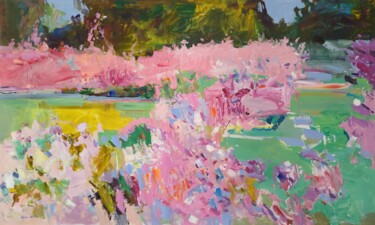
Yehor Dulin
Olej na Płótno | 47,2x78,8 in

Catherine Clare
Atrament na Tkanina | 41,3x63 in
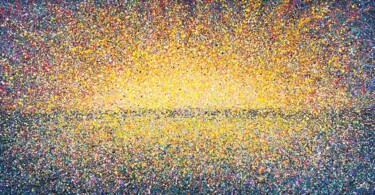
Nadiia Antoniuk
Akryl na Płótno | 43,3x80,7 in
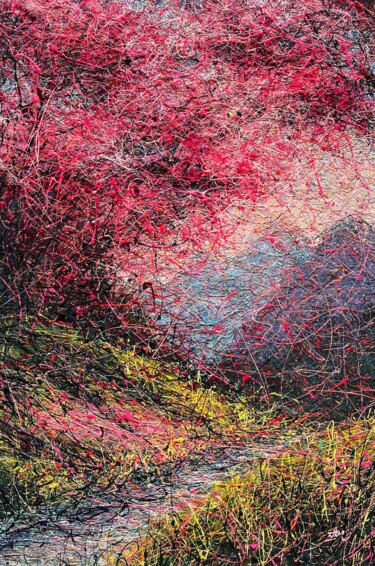
Nadiia Antoniuk
Akryl na Płótno | 61x43,3 in

Ruzanna Teterina
Olej na Płótno lniane | 31,5x59,1 in

Cecilia Frigati
Akryl na Płótno | 39x64,6 in
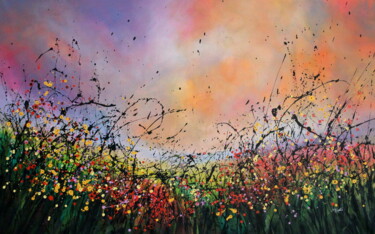
Cecilia Frigati
Akryl na Płótno | 39x64,6 in

Anh Tuan Le
Akryl na Płótno | 47,2x70,9 in
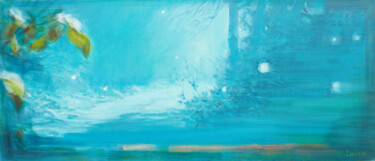
Alexander Levich
Olej na Płótno | 31,5x70,9 in

Lutz Gaede
Akryl na Płótno | 59,1x41,3 in
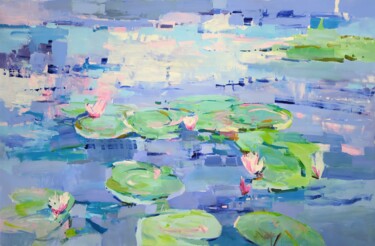
Yehor Dulin
Olej na Płótno | 51,1x78,8 in
